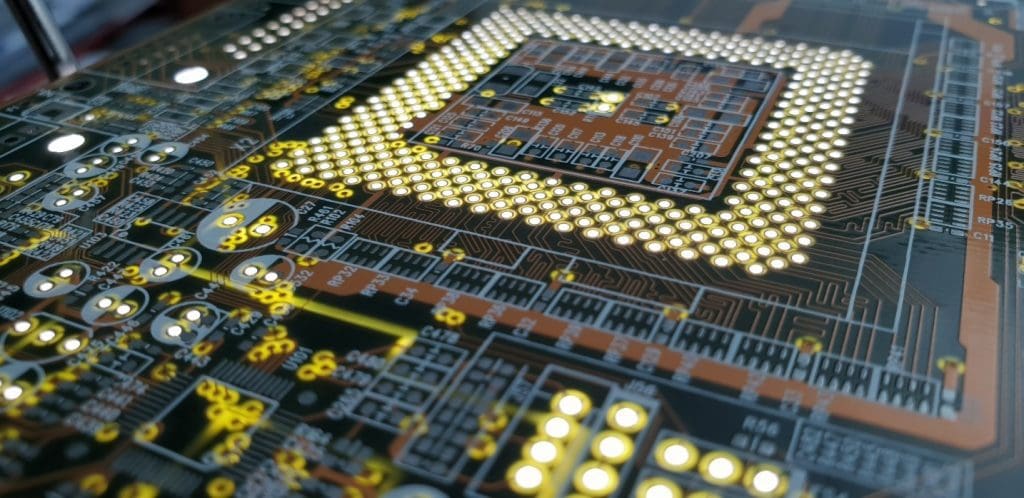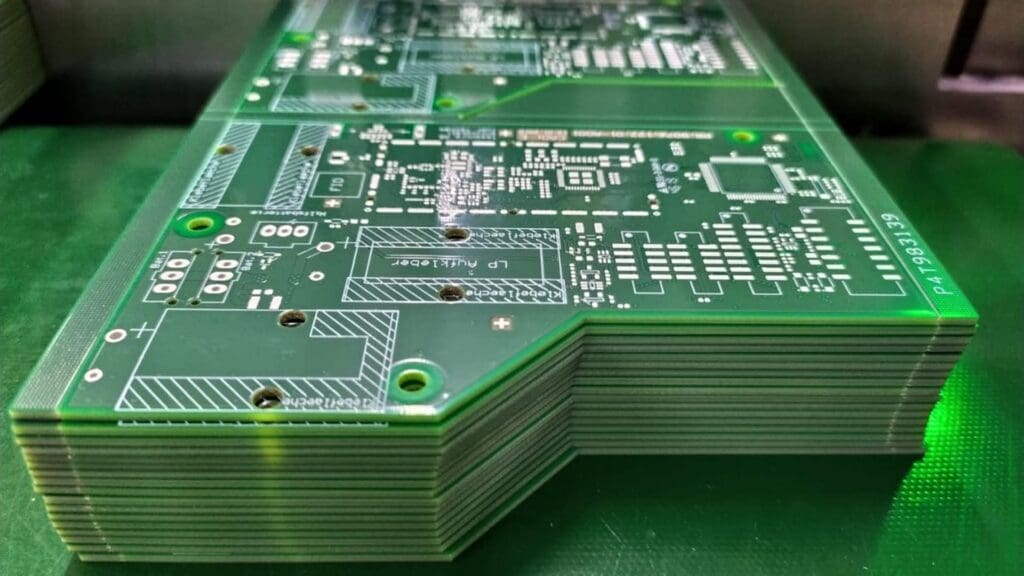Comprehensive guide to raw PCB Materials
Understanding the raw materials used in PCB manufacturing is crucial for optimizing performance, reliability, and cost-effectiveness. In this comprehensive guide, we delve into the various raw materials utilized in PCB fabrication, addressing key questions to provide valuable insights.
What Are PCB Raw Materials?
PCB raw materials consist of organic and nonorganic substrates and the copper conductive layer(s).
Organic substrates consist of paper cores impregnated with phenolic resins or layers of woven or nonwoven glass cloth impregnated with epoxy, polyimide, cyanate ester or BT resins.
Nonorganic substrates include ceramic, aluminum and copper-invar-copper.
Organic material selections depend on the physical attributes required by the PCB application such as operating temperature, frequency or mechanical strength.
Nonorganic material usage is primarily driven by the need for efficient heat dissipation.

Types of PCB Raw Materials
Substrates:
Substrates form the base to which the copper is bonded. This structure provides the support for the components. Common substrate materials include FR-4, CEM-1, CEM-3, ceramic filled hydrocarbon, PTFE, modified epoxy resins, BT (bismaleimide triazine), aluminum, ceramic, and flexible materials.
Conductive Materials
Conductive materials are used to create the circuit traces, pads, and vias on the PCB surface. Copper is the most widely used conductive material due to its excellent electrical conductivity and affordability. Other conductive materials include silver and gold for ceramic pcbs.

Application-Specific Raw Materials
High-Frequency Applications:
For high-frequency applications, specialized materials like modified epoxy resins or ceramic filled hydrocarbons offer superior electrical performance, low dielectric loss, and thermal stability.
RF/Microwave Applications:
For RF/microwave applications, ceramic filled hydrocarbons and ceramic filled PTFEs can meet the necessary performance requirements.
Thermal Management:
In applications requiring efficient heat dissipation, IMS (insulated metal substrate) like aluminum-based substrates is preferred due to their excellent thermal conductivity. Ceramic PCBs are also used for high-temperature applications where thermal management is critical.
Flexibility and Space Constraints:
Flexible PCB material, such as polyimide, is ideal for applications requiring flexibility and where space constraints are significant, such as wearable devices and medical implants.
Applications, Advantages and Disadvantages:
Printed Circuit Boards (PCBs) are integral components of electronic devices, providing mechanical support and electrical connections for various electronic components. The choice of PCB material depends on factors such as application requirements, cost considerations, and performance specifications. Here are some common types of PCB materials along with their applications, advantages, and disadvantages:

FR-4:
Application: FR-4 is the most widely used PCB material, suitable for a wide range of applications including consumer electronics, automotive electronics, industrial controls, military, avionics, medical devices and more.
Advantages:
Excellent electrical insulation properties
Good mechanical strength and dimensional stability
Affordable cost
Widely available
Disadvantages:
Limited thermal conductivity
Not suitable for punching

CEM-1:
Application: CEM-1 is commonly used in low-cost consumer electronics and household appliances.
Advantages:
Low cost
Good punching characteristics
Disadvantages:
Not suitable for double sided PCBs with plated holes
CEM-3:
Application: CEM-3 is commonly used in consumer electronics and household appliances.
Advantages:
CEM-3 can be used as a low-cost alternative to FR4 where higher levels of performance are not required
Has the advantage over CEM-1 in that the holes can be plated through
Suitable for punching
Disadvantages:
Not as widely available as FR4
FR-4 with Modified Epoxy Resin Systems:
Application: These materials are commonly used in high-performance applications such as high density interconnect (HDI) designs, aerospace, and telecommunications.
Advantages:
Good electrical performance at higher frequencies
Lower dielectric loss values compared to conventional FR4
Improved thermal stability over FR4
Disadvantages:
Higher cost compared to standard FR-4

IMS PCBs:
Application: IMS pcbs (insulated metal substrate) like aluminum-based PCBs are used in applications requiring efficient heat dissipation, such as LED lighting, power supplies, and automotive electronics.
Advantages:
Excellent thermal conductivity
Lightweight
Good dimensional stability
Relatively low price
Disadvantages:
Difficult to machine
Complicated to make more than one layer

Flexible PCBs (Flex PCBs):
Application: Flex PCBs are used in applications requiring flexibility or where space constraints are significant, such as wearable devices, medical devices, and automotive electronics.
Advantages:
Flexibility and bendability
Reduced size and weight
Flex used in combination with rigid creates more reliable board interconnects compared with cabling rigid pcbs
Disadvantages:
Higher cost compared to rigid PCBs
Limited mechanical strength compared to rigid PCBs
Ceramic PCBs:
Application: Ceramic PCBs are used in high-temperature and high-power applications, such as power electronics, LED packages, and sensors.
Advantages:
Excellent thermal conductivity
High-temperature resistance
Excellent dimensional stability
Disadvantages:
Higher cost compared to standard FR-4
Brittle nature may require careful handling during assembly
Only very few suppliers are able to manufacture Ceramic multilayers due to the process and extreme temperature requirements
Difficult to machine

Ceramic filled hydrocarbons/PTFEs:
Application: These materials are commonly used in high-frequency and high-performance applications such as RF/microwave circuits, aerospace, and telecommunications.
Advantages:
Excellent electrical performance at high frequencies
Low dielectric loss
Good thermal stability
Disadvantages:
Higher cost compared to standard FR-4
Limited availability of specific formulations
Conclusion:
Understanding the diverse array of raw materials used in PCB manufacturing is essential for optimizing the performance, reliability, and cost-effectiveness of electronic devices. By selecting the right materials based on application-specific requirements, the customer can expect the optimal performance from the pcb in its working environment.

Frequently Asked Questions (FAQs) Regarding PCB Raw Materials:
What are PCB raw materials?
PCB raw materials, which include the substrate and the conductive material, are the fundamental components used in the fabrication of printed circuit boards.
What types of substrates are commonly used in PCB manufacturing?
Common substrate materials include FR-4, CEM-1, CEM-3, ceramic filled hydrocarbons, PTFE, modified epoxies, aluminum, ceramic, and flexible materials. Each substrate has unique properties suited for different applications.
Which conductive materials are used to create circuit traces on PCBs?
Copper is the most widely used conductive material due to its excellent electrical conductivity and affordability. Other options include silver and gold for ceramic pcbs.
What are the advantages of using ceramic filled hydrocarbons or ceramic filled PTFE materials in PCB manufacturing?
These materials all offer superior electrical performance, low dielectric loss, and thermal stability, making them ideal for microwave and millimeter wave frequencies and RF applications.
Why are aluminum-based PCBs preferred for thermal management?
Aluminum-based PCBs offer excellent thermal conductivity, making them suitable for applications requiring efficient heat dissipation, such as LED lighting and power electronics.
What are the benefits of flexible PCB materials, and in which applications are they commonly used?
Flexible PCB materials, such as polyimide, provide flexibility, reduced size and weight making them ideal for wearable devices, medical implants, and automotive electronics.
How do ceramic PCBs differ from other substrate materials, and what are their advantages?
Ceramic PCBs offer excellent thermal conductivity, high-temperature resistance, and dimensional stability, making them suitable for high-temperature and high-power applications like power electronics and LED packages.
What are the key considerations when selecting PCB raw materials for a specific application?
Factors to consider include electrical performance, thermal management requirements, mechanical strength, cost considerations, and environmental factors.
How do I ensure the quality and reliability of PCB raw materials?
Quality assurance measures, such as material testing, supplier qualifications, and adherence to industry standards (e.g., IPC standards), are essential for ensuring the quality and reliability of PCB raw materials.